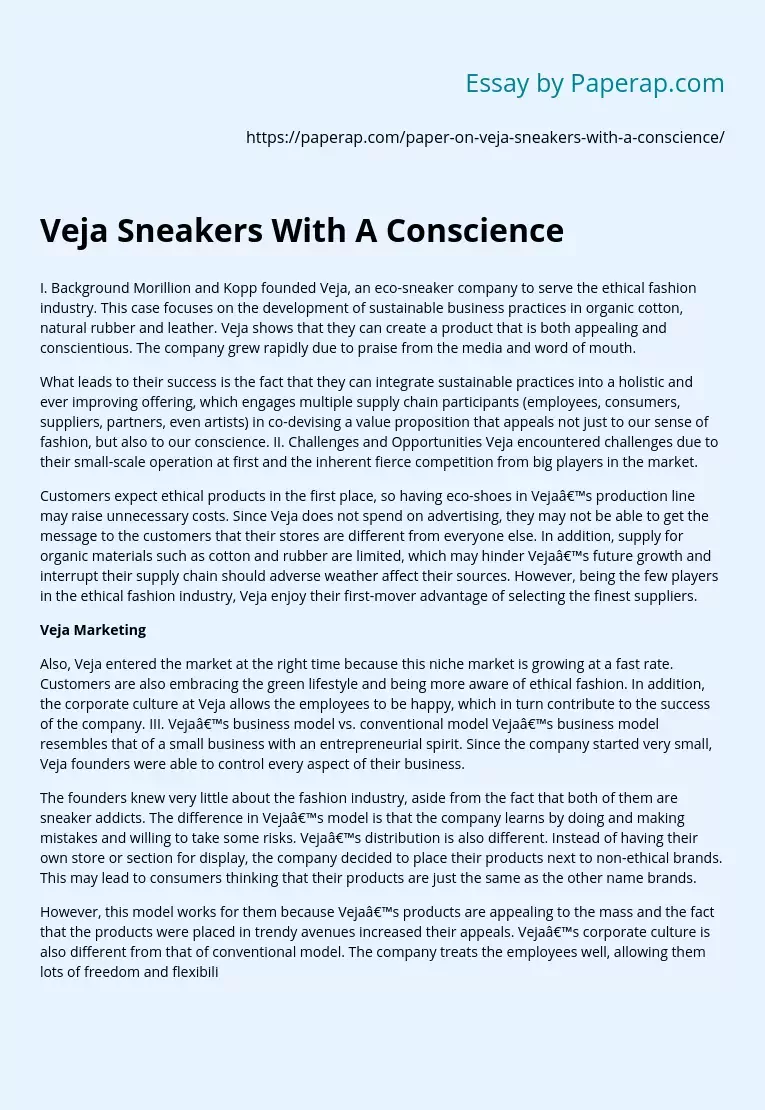Veja Sneakers With A Conscience
I. Background Morillion and Kopp founded Veja, an eco-sneaker company to serve the ethical fashion industry. This case focuses on the development of sustainable business practices in organic cotton, natural rubber and leather. Veja shows that they can create a product that is both appealing and conscientious. The company grew rapidly due to praise from the media and word of mouth.
What leads to their success is the fact that they can integrate sustainable practices into a holistic and ever improving offering, which engages multiple supply chain participants (employees, consumers, suppliers, partners, even artists) in co-devising a value proposition that appeals not just to our sense of fashion, but also to our conscience.
II. Challenges and Opportunities Veja encountered challenges due to their small-scale operation at first and the inherent fierce competition from big players in the market.
Customers expect ethical products in the first place, so having eco-shoes in Veja’s production line may raise unnecessary costs. Since Veja does not spend on advertising, they may not be able to get the message to the customers that their stores are different from everyone else.
In addition, supply for organic materials such as cotton and rubber are limited, which may hinder Veja’s future growth and interrupt their supply chain should adverse weather affect their sources. However, being the few players in the ethical fashion industry, Veja enjoy their first-mover advantage of selecting the finest suppliers.
Veja Marketing
Also, Veja entered the market at the right time because this niche market is growing at a fast rate.
Customers are also embracing the green lifestyle and being more aware of ethical fashion. In addition, the corporate culture at Veja allows the employees to be happy, which in turn contribute to the success of the company. III. Veja’s business model vs. conventional model Veja’s business model resembles that of a small business with an entrepreneurial spirit. Since the company started very small, Veja founders were able to control every aspect of their business.
The founders knew very little about the fashion industry, aside from the fact that both of them are sneaker addicts. The difference in Veja’s model is that the company learns by doing and making mistakes and willing to take some risks. Veja’s distribution is also different. Instead of having their own store or section for display, the company decided to place their products next to non-ethical brands. This may lead to consumers thinking that their products are just the same as the other name brands.
However, this model works for them because Veja’s products are appealing to the mass and the fact that the products were placed in trendy avenues increased their appeals. Veja’s corporate culture is also different from that of conventional model. The company treats the employees well, allowing them lots of freedom and flexibility, paying higher wages than most fashion companies. Veja also encourage work-life balance which show they care for the employees’ happiness. As a result, Veja was able to keep a lot of the original talents.
The founders created a supply chain that was based on sustainable relationships. Whereas the fashion industry was accustomed to contracting new parties as soon as a factory could deliver on time or cut costs, Veja tried to improve living conditions and to work cooperatively with supply chain to jointly develop the best product they could imagine. Veja bought raw materials directly from producers. The company paid a fixed price, which, though higher than the market price, was calculated by the farmers. This allowed the farmers to have a higher standard of living.
Veja also works solely with cotton and rubber families to produce organic materials. Doing so not only help preserve the Amazon rainforest, but also employ the families in the poverty-stricken area of northern Brazil. Also, Veja continues to research ways to make leather sustainable and works in collaboration with specialist in the field to ensure a sustainable product. This type process improvement mentality is rarely seen in the fashion industry. In contrast to conventional business model, Veja employs two distinct strategies: zero ads and zero stock.
Since most of the cost of producing a sneaker was dedicated to marketing, Veja was able to save on cost by having a no advertising policy. Veja benefitted widely from media coverage, blogs, and word of mouth due to their eco-friendly products and ethical business line. Also, most outlets had fewer Veja sneakers than they could sell. Veja did not produce extra, only according to orders placed six months in advance. Doing so ramped up Veja’s popularity because their products are now becoming scarce. Veja’s main business goal was not to make money only by having large volumes, but they want profitability with a conscience.
Veja Sneakers With A Conscience. (2019, Dec 05). Retrieved from https://paperap.com/paper-on-veja-sneakers-with-a-conscience/

